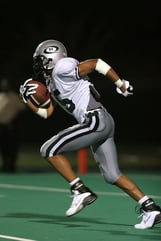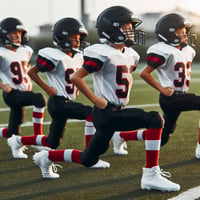The off-season is not just a time for rest and recovery; it's a golden opportunity for aspiring...
Elevating Game Speed: The Ultimate Guide to Speed Training for Football
In the high-octane world of football, speed isn't just a skill—it's a game changer. Whether it's a wide receiver breaking away for a touchdown or a defensive back closing in for a tackle, the ability to accelerate rapidly and sustain top speed can set elite players apart. This guide delves into the art and science of speed training, offering coaches and athletes insights into drills and techniques designed to boost maximum acceleration and achieve blistering linear top speeds.

The Foundations of Speed Training
Speed training for football is a multifaceted approach that targets various aspects of athleticism. It's not merely about running fast; it's about optimizing every element of movement to ensure that when a player needs to go from point A to point B, they do it faster than ever before.
1. Acceleration: The First Gear
Acceleration is the ability to reach top speed quickly. In football, the first few steps can make all the difference. Drills that improve explosive power and initial burst are crucial.
- Hill Sprints: Running uphill forces the body to work against gravity, enhancing leg strength and acceleration.
- Resisted Running: Using resistance bands or parachutes adds tension, improving stride power.
2. Linear Top Speed: The Open Field Dash
Once acceleration is achieved, maintaining and optimizing top speed is key. This phase focuses on stride length, frequency, and efficiency.
- Flying Sprints: Start with a run-up to reach near top speed, then sprint all out for a short distance. This drill emphasizes maximum velocity.
- Overspeed Training: Using slight downhill runs or assisted towing to exceed normal top speed, encouraging faster neuromuscular adaptation.
Key Drills for Speed Enhancement
1. Speed Ladders and Hurdles
These tools are excellent for improving footwork, agility, and speed. Quick, precise foot strikes and high knee lifts enhance acceleration.
2. Sprint-Float-Sprint (SFS) Drills
This drill segments the sprint into an initial all-out effort, a 'float' phase with slightly reduced speed, and another all-out sprint. It mirrors the game's natural rhythm of speed changes.
3. Plyometric Training
Plyometrics, such as box jumps and bounding, develop explosive power, crucial for that initial burst of speed.
Integrating Speed Training into Football Practice
To effectively incorporate speed training, it's essential to balance intensity and recovery. Speed work should be done when players are fresh, often at the beginning of practice after a thorough warm-up. Typically, two to three speed sessions per week are sufficient, allowing ample recovery to prevent overtraining and injuries.
Advanced Techniques and Considerations
1. Video Analysis
Use video to analyze and correct running form. Look for efficient arm swing, optimal stride length, and proper foot strike patterns.
2. Customization
Tailor speed training to the player's position and individual needs. A lineman's acceleration will differ from a wide receiver's linear speed requirements.
3. Strength, Recovery, and Nutrition
A well-rounded weight training program that builds relative body strength goes hand in hand with improving speed. Adequate rest, proper hydration, and nutrition are just as critical as the training itself. Incorporate recovery strategies, including cool-down routines, stretching, and possibly foam rolling.
The Winning Edge
In football, every fraction of a second counts. Speed training, when executed correctly, can provide that critical edge needed to outperform the competition. It's about more than just drills; it's about cultivating an ethos of speed, precision, and relentless improvement. As coaches and athletes, the pursuit of speed is a journey that never truly ends, but with dedication, the rewards are boundless—on the scoreboard and beyond.


